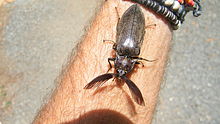| Tetralobus flabellicornis | |
|---|---|

| |
| Museum specimen of Tetralobus flabellicornis | |

| |
| Male specimen of Tetralobus flabellicornis | |
| Scientific classification | |
| Kingdom: | |
| Phylum: | |
| Class: | |
| Order: | |
| Family: | |
| Subfamily: | |
| Genus: | |
| Species: | T. flabellicornis
|
| Binomial name | |
| Tetralobus flabellicornis (
Linnaeus, 1767)
| |
Tetralobus flabellicornis, the Giant Acacia Click Beetle, is a species of click beetle belonging to the family Elateridae.
Description
Tetralobus flabellicornis can reach a length of 60–80 millimetres (2.4–3.1 in). This large click beetle has a dark brown to black body covered with a brownish grey pubescence, the latter showing a weak to medium reflectance in the near-infrared. [1] The quite long antennae carry large lamellae in males, while they are serrate in females. Larvae live in the termite nests. These beetles feed on Acacia trees.
Distribution and habitat
This species is widespread in South Africa, Namibia, Democratic Republic of Congo, Senegal, Zambia, Zanzibar, Liberia and Zaire. It lives in savannah and subtropical forests.
See also
References
- ^ Mielewczik, Michael; Liebisch, Frank; Walter, Achim; Greven, Hartmut (2012). "Near-Infrared (NIR)-Reflectance in Insects – Phenetic Studies of 181 Species" (PDF). Entomologie heute. 23: 183–215.
- Biolib
- in Synopsis of the described Coleoptera of the World
- Mike Picker, Charles Griffiths, Alan Weaving Field Guide to Insects of South Africa
- Hans G. Schabel Forest Entomology in East Africa: Forest Insects of Tanzania
| Tetralobus flabellicornis | |
|---|---|

| |
| Museum specimen of Tetralobus flabellicornis | |

| |
| Male specimen of Tetralobus flabellicornis | |
| Scientific classification | |
| Kingdom: | |
| Phylum: | |
| Class: | |
| Order: | |
| Family: | |
| Subfamily: | |
| Genus: | |
| Species: | T. flabellicornis
|
| Binomial name | |
| Tetralobus flabellicornis (
Linnaeus, 1767)
| |
Tetralobus flabellicornis, the Giant Acacia Click Beetle, is a species of click beetle belonging to the family Elateridae.
Description
Tetralobus flabellicornis can reach a length of 60–80 millimetres (2.4–3.1 in). This large click beetle has a dark brown to black body covered with a brownish grey pubescence, the latter showing a weak to medium reflectance in the near-infrared. [1] The quite long antennae carry large lamellae in males, while they are serrate in females. Larvae live in the termite nests. These beetles feed on Acacia trees.
Distribution and habitat
This species is widespread in South Africa, Namibia, Democratic Republic of Congo, Senegal, Zambia, Zanzibar, Liberia and Zaire. It lives in savannah and subtropical forests.
See also
References
- ^ Mielewczik, Michael; Liebisch, Frank; Walter, Achim; Greven, Hartmut (2012). "Near-Infrared (NIR)-Reflectance in Insects – Phenetic Studies of 181 Species" (PDF). Entomologie heute. 23: 183–215.
- Biolib
- in Synopsis of the described Coleoptera of the World
- Mike Picker, Charles Griffiths, Alan Weaving Field Guide to Insects of South Africa
- Hans G. Schabel Forest Entomology in East Africa: Forest Insects of Tanzania